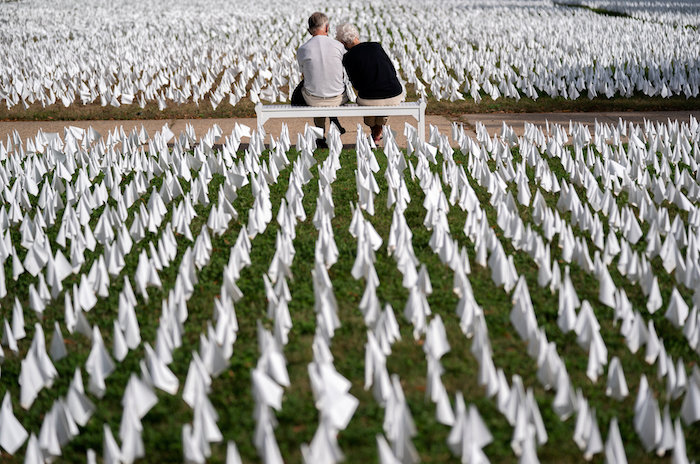In fall 2020, thousands traveled across the country to visit the COVID-19 public art installation “In America How Could This Happen…” Just two miles east of the U.S. Capitol, the exhibition featured hundreds of thousands of small white flags, personalized to commemorate individual lives lost during the pandemic.
Now, anthropologists from George Washington University’s Columbian College of Arts and Sciences have teamed with the memorial’s Washington, D.C., artist Suzanne Brennan Firstenberg and scholars from the University of Maryland to launch a digital version of “In America” that continues paying tribute to COVID victims.
“While the physical exhibition has ended, the deaths from COVID-19 continue,” Ms. Firstenberg said. “We hope this digitized version of the art will provide national acknowledgement and comfort for everyone who has lost loved ones.”
The digital version of the flag installation includes dramatic drone images of the exhibition, an interactive map of personalized flags and a search tool to help visitors find loved ones’ names. The online memorial allows users to add digital flags with personalized messages. Other interactive components include a “bird’s-eye-view” feature that displays before-and-after images of the exhibition’s construction.
The collaboration grew from Ms. Firstenberg’s conversations with Associate Professor of Anthropology Sarah Wagner about the GW research project “Rituals in the Making,” a National Science Foundation-funded study of COVID’s impact on funeral, burial and commemorative practices
Dr. Wagner and the project’s faculty and student research team are largely focusing on how mourning rituals move into digital spaces. “In America” and its field of flags, she noted, fill a gap by offering insights into the improvised, creative forms used to remember lives lost to the pandemic.
“Over and over in our research, we’ve heard from families, clergy, funeral directors and hospice workers that COVID-19 has robbed people of not only their loved ones but also the ability to mourn together and draw support from one another,” she said. “Suzanne’s installation utterly overpowered me—it was one of the few spaces that insisted we acknowledge the scale of loss by recognizing each life. The digital version keeps that going, flag by added flag.”
Students, staff and faculty from both universities visited the installation over Thanksgiving weekend to begin the mapping process. Under the direction of Dr. Wagner and Adam Fracchia, a University of Maryland assistant research professor of anthropology, the group systematically worked their way through the installation, physically marking, labeling and plotting the individual locations of each flag that included a dedication message.
Archaeologist Maggie Peterson, a graduate student in geographical information systems at GW, collected the physical graph paper maps and created a digital map. She used the Esri's mapping software ArcGIS to match the ground coordinates of the installation. With the support of other GW students, the group recorded each flag’s dedication message and individual geolocation, linking the virtual flag to a photograph of the actual flag placed at the physical installation.
“At the physical memorial, my mind raced on how to help continue this installation,” Ms. Peterson said. “ArcGIS StoryMaps came to mind as an ideal format for telling the story of the installation and emphasizing the intersecting aspects of this collaboration. We combine visual art, data analysis and human interaction into one space, which enables people to comprehend the massive impact this virus has on a fathomable scale, while also highlighting every individual’s story.”


